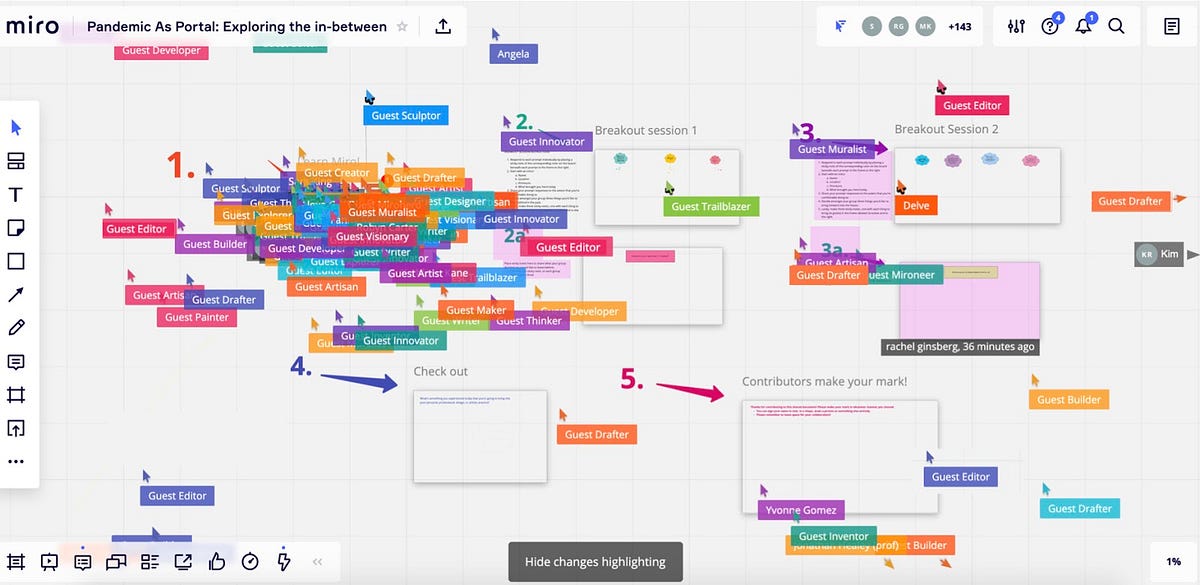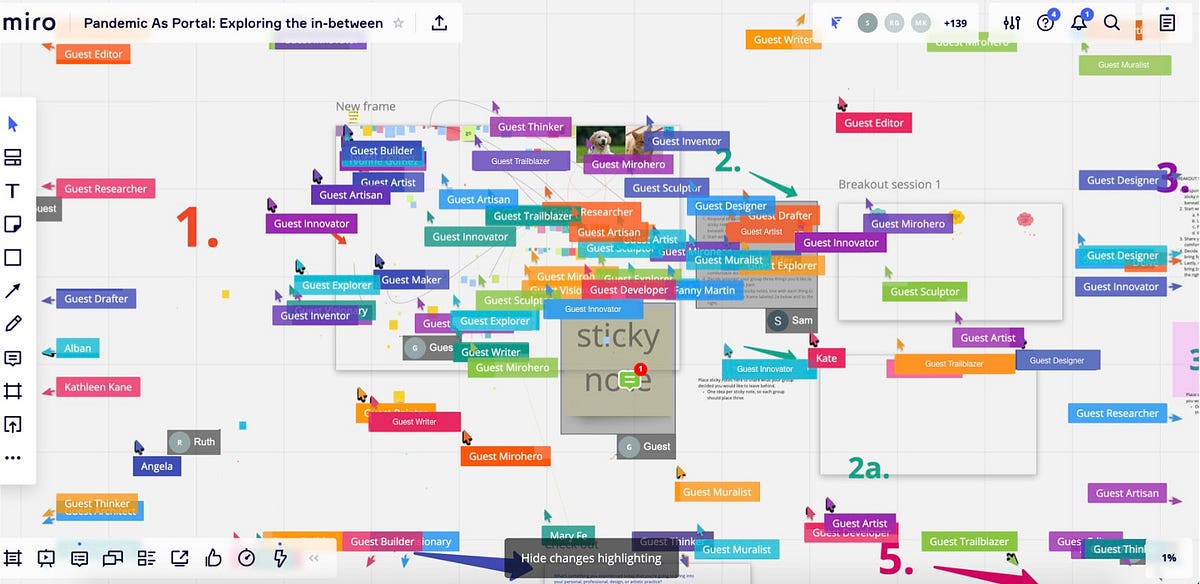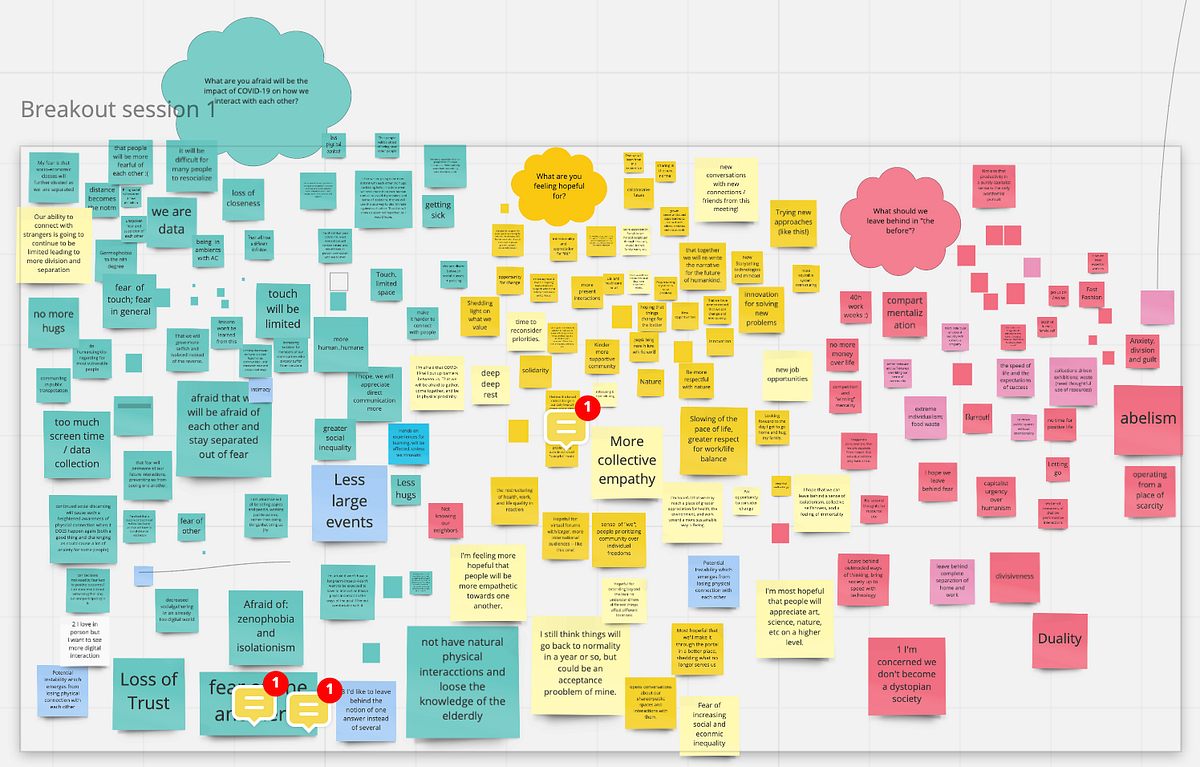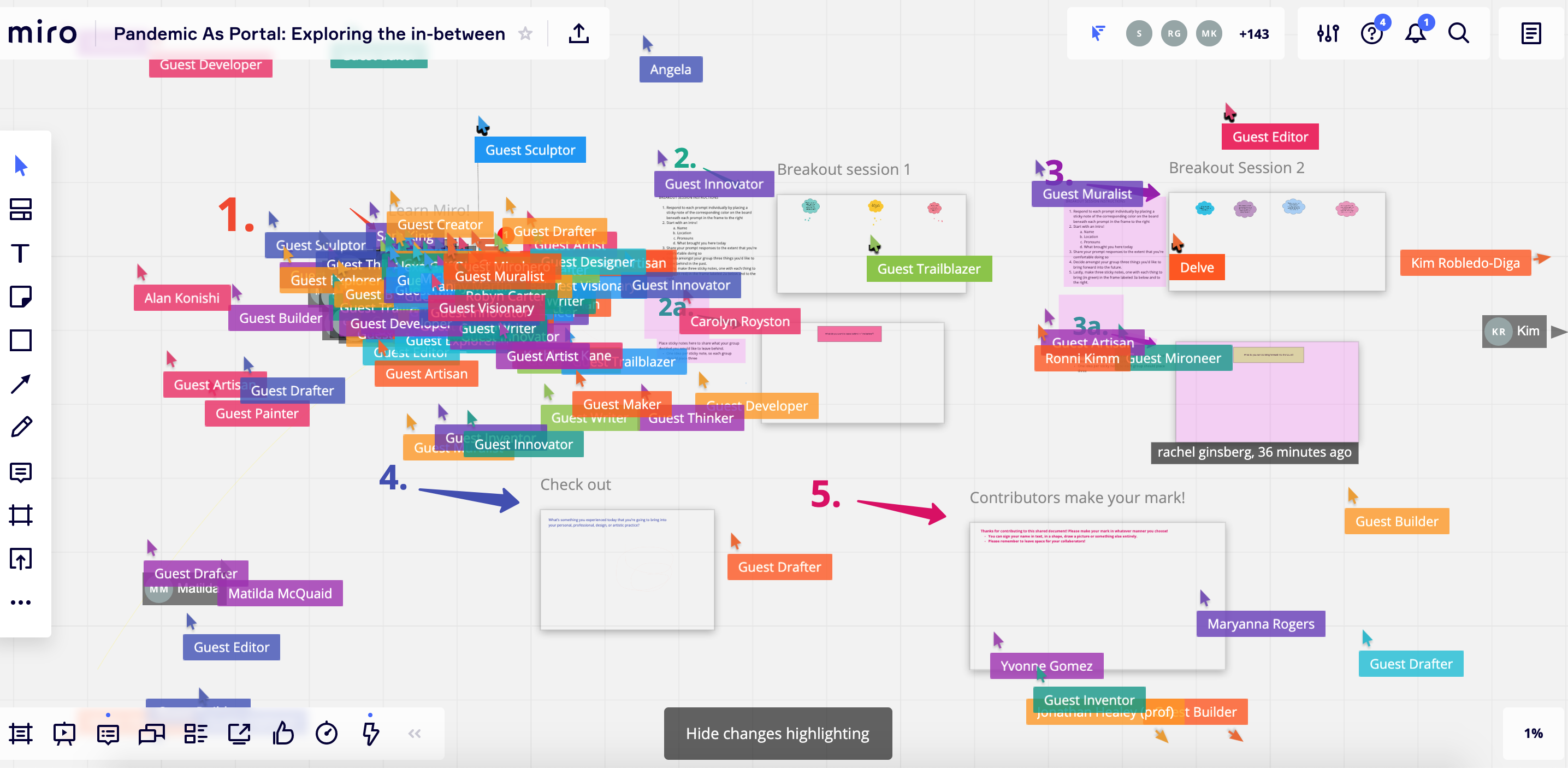A note: This article was co-written by Angela Perrone, Katherine Miller, and Rachel Ginsberg before the events of the past few weeks, in a world that feels yet again very different. Rather than rewriting, we’ve decided to publish as is. We stand in solidarity with those organizing against institutionalized racism and discrimination in all forms, and look forward to integrating more prominent discussions around diversity, equity, access, and inclusion into upcoming Interaction Lab programming.
Well before the pandemic changed everything, the Interaction Lab was committed to running large scale collaborative events. Our public program series, launched in September 2019, convened conversations and engaged participants in conversation around a wide range of topics related to the intersection between museum studies, experience design, storytelling, and emerging technology. The plan for Spring 2020 was to continue our event series with deeper exploration of the relationship between interpretation, storytelling, and information design. Then COVID-19 happened. We knew we wanted to convene our community, but needed to alter the conversation to reflect a changed world.
Pandemic as Portal: Exploring the In Between, was an experiential collaboration that brought together over 175 people from many countries for a two-hour experiment. The theme and the name was based on a now-famous section of Arundhati Roy’s Financial Times piece by that name.
Whatever it is, coronavirus has made the mighty kneel and brought the world to a halt like nothing else could. Our minds are still racing back and forth, longing for a return to “normality”, trying to stitch our future to our past and refusing to acknowledge the rupture.
But the rupture exists. And in the midst of this terrible despair, it offers us a chance to rethink the doomsday machine we have built for ourselves. Nothing could be worse than a return to normality.
Historically, pandemics have forced humans to break with the past and imagine their world anew. This one is no different. It is a portal, a gateway between one world and the next.
-Arundhati Roy
The purpose of this article is to share our experience designing and running this online program. It is our hope to provide insight on: (1) how to run collaborative events at a distance, (2) acting as a resource for those considering some of the same questions we are asking — what’s on the other side of the portal, and (3) various ways to collaborate with our communities during this time of required physical distance.
This first online event marked the beginning of a larger conversation about our current reality, which we hope will drive exploration about future cultural experiences, foster community, provoke collaboration, and build a repository of knowledge and approaches to be shared openly with all. One incredible opportunity the pandemic has generated is the ability to interact with people all over the world, most of whom would never have the opportunity to attend an Interaction Lab program in person. Based on our follow up survey, about 70 percent of participants had never before attended an Interaction Lab program.
The structure of the program prioritized bringing participants together in conversation to explore (1) how we’re experiencing this time of collective pause, similarly and differently, and (2) share our individual perspectives, values, and priorities for the world ahead. The hope is having conversations like this while inside the portal will move us together toward some shared understanding. Only then might we be able to build inclusive visions of the future that reflect our collective ambitions for experiences of all kinds, cultural sector and beyond.
The Experiment
Despite having expected a good response, we were nonetheless amazed by how quickly we reached capacity in ticket sales. We had five people in total on hand to run the event to facilitate, support documentation, handle technology, and assist participants as needed.
Though we designed the event based on proven, in-person formats, facilitating these kinds of activities virtually is quite different. It required many adjustments to timing and facilitation style, like, for example, explaining things takes longer. We scheduled the program for early afternoon eastern time, which allowed European and Central Asian colleagues to join, while also covering the Americas from coast to coast. Because that timing decision meant many people would be attending during working hours, we committed to a 90-minute running time in the hope that it would help people attend for the whole program. Here’s how it went.
One of the most crucial pieces of this experiment was ensuring a smooth and comprehensive set of instructions for the various activities in the workshop and the software we were going to use to collaborate. We asked participants to change their display names to first names only, with location and pronouns to their comfort. This was to ensure we weren’t collecting any personally identifying information as we recorded sections of the program, and to ensure our focus was more on the personal than the professional.
Ruth Starr, Cooper Hewitt’s accessibility manager, highlighted accessibility features, including live captioning, and shared instructions and behavioral ground rules to guide interactions in this distributed environment.
To make it possible to document collaboratively we turned to browser-based digital whiteboarding software, Miro. We’ve been thinking about Miro as a flexible toolkit that gives us a space to think collaboratively and share in real time. Pandemic as Portal was the first time we had introduced the platform to a large group for this purpose, and our audience was quite diverse in age and background, so onboarding was an uneven proposition, very steep for some, and less so for others. When we were in the midst of the process, it was critical to make sure everyone present understood that it was ok to not “get it” immediately. For this reason, we designed an event that included collaborative platforms, where full participation did not depend on any one person’s ability to use them.

Because Miro offers a vast flexible digital space, designing wayfinding into the experience of using it is really important. We designed the board we used for the event to provide a wayfinding framework that allowed participants to navigate easily from one activity to the next. Each section of the board was labeled and color-coded to make it easy to find and to help participants understand what to do when they got there. We treated it like a series of worksheets, created in advance based on the activities we had planned. We had to account for participants using the Miro board while in breakout rooms. That meant we had no central chat feature to reach all participants immediately. For that reason, we had staff members on hand to move between breakout rooms to answer individual questions.

The Discussion
Once we had demonstrated the necessary Miro features — and attendees were (more or less) with us — we sent them into breakout rooms in groups of four to have a prompt-driven discussion. We had two rounds of breakout conversation each lasting about 20 minutes.
The first breakout session was meant to address how we’re connecting what life was like before with the new world on the other side of the portal. To set up participants for discussion, prompts focused on fears related to COVID-19 and how we interact with each other, hopeful outcomes, and what to leave behind in “the before.”
- What are you afraid will be the impact of COVID-19 on how we interact with each other?
- What are you feeling hopeful for?
- What should we leave behind in “the before?”
Participants’ fears were focused around a few key areas: how loss of touch and physical closeness might challenge intimacy, overloading on digital interaction (and related behavioral and privacy concerns), with much concern about social impacts and unknowns. The hopeful responses widely acknowledge the potential to reimagine our society post-COVID. Participants’ hopes were lofty, inspiring, and focused on more collectivism with people and nature, prioritizing connection and care, and slowing down to take stock of what’s important. When moving through the portal to this new future, people want to leave behind “old ways,” referencing things like, burnout and overwork, individualism and greed, wastefulness, selfishness, lack of empathy. One participant summed it up beautifully. They wanted to leave behind ”the notion that things should continue as they have in the past because ‘that’s how it’s always been done.’”

For the second breakout, we had initially intended to split participants into different groups than the first. When we were just about to begin that portion of the program, a participant chimed in verbally to suggest that we stick with the same breakout groups. We put the question to the rest of the group and received overwhelming agreement, so that’s what we did.
The prompts for the second breakout session were designed to uncover what we have learned from our experiences and interactions during the pandemic, and how we might carry those things forward into the future.
- Where are you finding inspiration in these times?
- What do you like about new ways of interacting that are arising/becoming common during the crisis?
- What are you learning, experiencing or observing now that you want to bring forward into the future?
- What do you love most about interacting IRL (in real life)? (if you don’t love it, then what do you dislike about it most?)
The second breakout session highlighted how this time (inside the portal) gives opportunity for inspiration, learning, and change for the future. People noted that they missed physical interactions, hugs, shared spaces, and the spontaneity of communal life. However, we seem to be finding inspiration through shared experiences, virtual communication, reconnecting with various and global people and communities, and time for personal reflection. In response to the prompt about what we’re learning now that we should bring forward into the future, one participant wrote: “Can we do this? → We’re going to do this.” This spirit and resolve was pervasive throughout the discussion. This is a difficult time, but an inspiring one.
Together, both sets of prompts were meant to begin to surface information that will help us to design the future on the other side of the portal and the experiences it might contain. Thus far, the data we documented demonstrates participants’ strong belief that we are entering a new era, in which we can improve on old methods, engage and embrace community, cultivate deeper respect for humanity and those underrepresented, and prioritize what was overlooked in the before.

The Community
The primary goal for this collaborative environment was to engage and expand our community, to plant global seeds of community, and see conversations and ideas might grow. After the breakout sessions and closing remarks, we kept the zoom room open for an “after-party” discussion for another hour. We hadn’t made specific facilitation plans for that time but wanted to leave it up to the people who joined us. What transpired was a large group conversation that expanded in many different directions.The group talked about the division and importance of essential labor, designing interactive programming both on- and off-line, and ideas for the future of design that respect the new and intense constraints of our current situation.
Overall, Pandemic as Portal was an experiment in content and format. To initiate a large collaborative design process through a public program is not an easy thing. To combine multiple collaborative platforms (one entirely new one) and ask people to interact with them in real time is not an easy thing. But both experiments bore fruit in a number of ways, beyond the experience shared by those who attended. The artifact we created together is still live and accessible, and will remain open to public comment until our next program.
In upcoming Interaction Lab programs, we’re committed to retaining the same collaborative, discussion-based format and documentation approach, but with a trimmed-down agenda that builds on our learnings from this first.
90 minutes is not a lot of time. Even with a very stripped down format, it still wasn’t enough to accomplish everything we tried to do. In this case, sticking with 90 minutes was important to us for two reasons: the time of day, the exhausting nature because of the time of day, and a desire to not keep people for an extended period. We gave participants the opportunity to continue the conversation for a further hour, and we were surprised and delighted that 40 people stayed on Zoom to participate.
Enough time for substantive conversation must be an agenda priority. One of the core design priorities of the program was to differentiate from the many webinars currently on offer by creating a participatory format. Participant feedback we received about the small group discussion was almost uniformly positive, though some participants were caught off guard at the level of participation the program required. Though we sent out communications to the effect in advance, we should always assume that people will miss them and we should aim to scaffold the experience for those that need it.
Group documentation is effective and powerful, but thorough onboarding takes time. Introducing people to an entirely new platform (Miro) proved extremely valuable but was also difficult and was alienating for some. Those who hung in through the challenges shared feedback that they were glad they did, because issues with the technology did not hinder their ability to participate. In the future, we‘ll provide more help upfront when introducing new technology.
Granting permission to fail is part of good facilitation. We ran into some challenges during the event, which is totally normal under the best of circumstances and even more in this one. One thing that makes these kinds of things easier is acknowledging their difficulty often and out loud while in the situation. Though we did some of that at this first event, we could have done more. Overall, participants were appreciative of our efforts to experiment with new formats and approaches.

Authors
Angela Perrone is the Interactive Gallery Technology Assistant at Cooper Hewitt, Smithsonian Design Museum. Right now we face a time that is ripe for innovation in the world and she is thrilled to be part of the conversation and ideation of this moment. This is 2020…and beyond.
Katherine Miller is a Senior Visitor Experience Associate at Cooper Hewitt, Smithsonian Design Museum. Although the museum experience might never be the same, she is excited to explore the possibilities for the future. “All we have to decide is what to do with the time that is given us”- J.R.R. Tolkien.
Rachel Ginsberg is the Director of the Interaction Lab, Cooper Hewitt’s visitor experience design lab. The Interaction Lab is bringing interactive design methodology to the very heart of Cooper Hewitt’s visitor experience — across digital, physical, and human interactions. To keep track of Lab activities, sign up for our mailing list.
